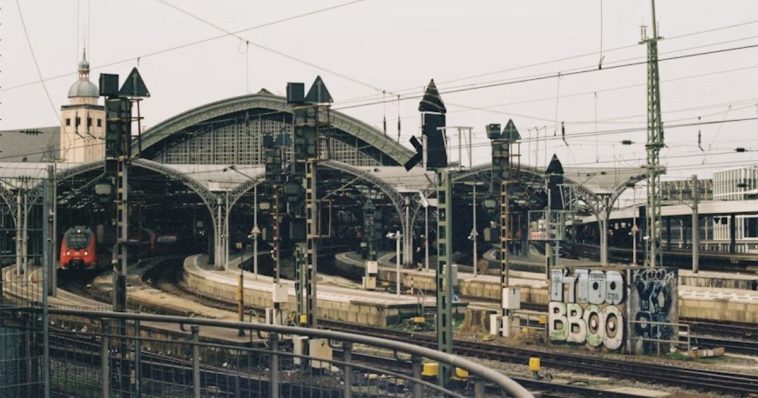Train stations are often thought of as simple transit points—places to board a train and continue on a journey. Yet across the world, certain stations rise far above this utilitarian role, transforming into architectural masterpieces that capture the imagination. From soaring ceilings and sweeping staircases to ornate details and gilded accents, these spaces combine history, art, and craftsmanship, turning ordinary travel into a visual and cultural experience.
More than just gateways to cities, these stations invite exploration and admiration. Visitors can pause to appreciate grand halls, intricate facades, and thoughtful design elements that rival those found in the finest museums. Each station tells a story of its city and era, offering a unique blend of functionality and aesthetic wonder that makes every arrival or departure feel like a moment worth savoring.
7 Breathtaking Train Stations That Turn Travel Into Art

1. Grand Central Terminal, New York, USA
Few train stations in the world can rival the iconic grandeur of Grand Central Terminal. Since its opening in 1913, this Beaux-Arts marvel has stood as a testament to architectural ambition, blending monumental scale with exquisite detail. Step into the Main Concourse, and your eyes are drawn upward to the breathtaking celestial ceiling mural, where golden constellations dance across a vivid turquoise sky, evoking a sense of wonder and timeless elegance. Sweeping marble staircases, glimmering brass accents, and ornate chandeliers create an atmosphere of refined sophistication, making each visit feel like stepping into a living masterpiece.
Yet Grand Central is more than just a station—it’s a vibrant cultural destination. Throughout the year, it hosts artisanal markets, immersive exhibitions, and seasonal events that transform ordinary commutes into memorable experiences. From the whispering gallery’s playful acoustics to the hidden dining gems tucked within its corridors, every corner invites exploration, ensuring that Grand Central remains not only a transportation hub but also a celebration of history, artistry, and New York’s enduring spirit.
2. St. Pancras International, London, UK
St. Pancras International is more than just a train station—it is a breathtaking tribute to Victorian grandeur. From the moment you approach its towering Gothic façade, with its intricate stone carvings and ornate ironwork, the station evokes the elegance of a bygone era. Step inside, and the soaring arches of the main concourse, bathed in natural light from the immense glass roof, create a cathedral-like atmosphere. At the same time, the lavish interior detailing—polished marble floors, decorative iron columns, and gilded accents—makes every visitor feel as though they’ve entered a grand hotel lobby.
Beyond its architectural splendor, St. Pancras serves as a bustling hub of modern travel. As the London terminus of the Eurostar, it connects the city to continental Europe with ease, yet still retains a strong sense of history through carefully preserved sculptures, commemorative plaques, and heritage signage. The adjoining St. Pancras Renaissance Hotel adds a touch of luxury, blending seamlessly with the station’s design and offering guests a unique opportunity to experience Victorian opulence firsthand. Whether arriving for a journey or to admire its beauty, St. Pancras International stands as a harmonious fusion of history, artistry, and modern functionality, capturing the imagination of travelers and architecture enthusiasts alike.
3. Antwerpen-Centraal, Antwerp, Belgium
Often hailed as the “Railway Cathedral of Belgium,” Antwerpen-Centraal is a masterpiece of architecture and design that leaves visitors in awe. Completed in 1905, the station is a stunning fusion of neo-Renaissance grandeur and industrial ingenuity. Its majestic façade, adorned with ornate stone carvings and sculpted figures, announces the splendor within, while the domed train hall, crowned by an immense glass ceiling, floods the space with natural light, illuminating gilded details, intricate ironwork, and elegant arches that feel more like a palace than a bustling railway station.
Inside, the sense of drama continues with a sweeping marble staircase that gracefully leads travelers to the platforms, offering panoramic views of the hall’s architectural splendor. Every corner is a study in craftsmanship—from delicate mosaics to the elaborate clock that presides over the concourse—reminding visitors that Antwerpen-Centraal is not merely a transit point, but a living celebration of Belgian artistry and heritage. Even amid the steady flow of commuters, the station exudes a sense of timeless elegance, making it a must-see destination for both travelers and admirers of European architecture.
4. Chhatrapati Shivaji Maharaj Terminus, Mumbai, India
Chhatrapati Shivaji Maharaj Terminus (CSMT) is a breathtaking blend of history, culture, and architectural mastery—a true jewel of Mumbai and a UNESCO World Heritage Site. Completed in 1887 to commemorate Queen Victoria’s Golden Jubilee, the station exemplifies Victorian Gothic Revival architecture infused with traditional Indian elements. Its soaring turrets, pointed arches, and intricately carved stone façades tell a story of colonial influence meeting local craftsmanship, creating a design that is both grand and uniquely Indian. Sculpted statues, detailed ornamentation, and stained-glass windows give the exterior an almost palace-like quality, making it a magnet for architecture enthusiasts and photographers alike.
Inside, the station continues to impress with vast high-ceilinged halls, intricately carved wooden doors, and ornate ironwork that reflect Mumbai’s colonial past. The intricate detailing—from the decorative columns to the elaborate domes—showcases the painstaking craftsmanship of 19th-century artisans. Amidst this architectural splendor, the station remains a bustling transport hub, with thousands of commuters weaving through its halls daily. For travelers, CSMT presents a unique opportunity to experience a living piece of history: a space where everyday life, monumental design, and cultural heritage converge. Whether observing the flow of passengers, marveling at the sculptures, or admiring the ornate interiors, a visit here transforms a simple train ride into a journey through time and artistry.
5. Kanazawa Station, Kanazawa, Japan
At first glance, Kanazawa Station dazzles with its sleek, contemporary design; however, a closer look reveals a thoughtful blend of modern architecture and profound cultural symbolism. The station’s most striking feature is the Tsuzumi-mon Gate, a towering wooden structure inspired by the traditional tsuzumi drum used in Japanese Noh theater. Its intricate latticework and gently curving form create a sense of ceremonial grandeur, instantly welcoming visitors while paying homage to Kanazawa’s rich artistic heritage. This gateway isn’t just functional—it’s a statement piece that seamlessly merges art, history, and modern engineering, transforming the arrival experience into an aesthetic event.
Inside, the station opens up into a vast, airy concourse filled with natural light that streams through glass walls and skylights. The minimalist yet meticulously detailed design provides a serene, almost meditative atmosphere, contrasting with the hustle of daily commuters. From the polished wooden beams to the subtle nods to local craftsmanship throughout the station, every element appears to be carefully curated.
Kanazawa Station is more than a transit hub—it’s a cultural showcase. In this place, travelers can pause and admire the artistry of contemporary Japanese design while feeling deeply connected to the region’s history and traditions. For many visitors, stepping through this station feels less like catching a train and more like walking into a museum where the city’s spirit is on full display.
6. Liège-Guillemins, Liège, Belgium
Liège-Guillemins is a striking example of contemporary architecture, designed by the world-renowned architect Santiago Calatrava. The station’s design evokes the feeling of walking inside a futuristic cathedral, with sweeping white steel arches that curve gracefully overhead and glass walls that flood the space with natural light. Its fluid, organic lines create a sense of movement even when the station is still, giving travelers the impression that the building itself is alive, pulsing with energy and light. Every angle reveals a thoughtful balance of artistry and structure, making it a destination where architecture becomes an immersive experience.
Beyond its visual grandeur, Liège-Guillemins is a triumph of functionality. The expansive concourse, wide platforms, and clear sightlines facilitate smooth navigation, while integrated seating areas, information displays, and modern amenities ensure passenger convenience. The station’s design elevates everyday travel into a cultural encounter, blurring the line between transportation hub and art gallery. Visitors often pause to admire the elegance of the soaring arches and the interplay of shadows and reflections, reminding them that Liège-Guillemins is more than a station—it is a celebration of modern architectural brilliance and a testament to what contemporary design can achieve.
7. Antwerp-Central, Madrid-Atocha, and Beyond
Beyond the iconic landmarks of Grand Central and St. Pancras, train stations worldwide offer their own unique blends of history, architecture, and artistry. Madrid-Atocha in Spain, for example, surprises travelers with its verdant indoor tropical garden, where palm trees, ferns, and ponds create an oasis of calm amid the bustle of commuters. The station’s blend of modern infrastructure and natural beauty transforms a simple transfer or arrival into an unexpectedly serene experience.

In Italy, Florence’s Santa Maria Novella station embodies the city’s Renaissance elegance, characterized by clean lines, harmonious proportions, and subtle decorative flourishes that reflect the artistry of the surrounding historic streets. Each of these stations—from the grand domes of Antwerpen-Centraal to the futuristic arches of Liège-Guillemins—tells a story of its city, serving not just as points of departure and arrival but as immersive cultural experiences. They remind travelers that train stations are more than mere transit hubs: they are portals where history, art, and daily life converge, ensuring that every journey begins and ends with a touch of wonder.
Train Stations That Turn Travel Into Art
What makes these train stations so remarkable is their ability to transform the mundane act of travel into an immersive experience. From celestial ceilings and Gothic arches to futuristic steel and glass, each station captures a city’s history, culture, and artistic vision. For travelers, they serve as reminders that beauty can be found in unexpected places, transforming everyday journeys into opportunities to marvel, reflect, and capture moments in photographs.
Whether it’s marveling at the architectural splendor of Grand Central, wandering through the lush indoor gardens of Madrid-Atocha, or standing under the glass dome of Antwerpen-Centraal, these stations remind us that even a transit hub can be a museum. In this place, art, history, and daily life converge.



